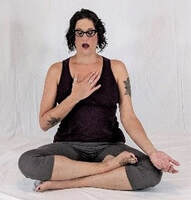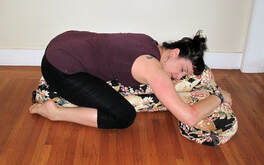|
Cheryl Fenner Brown, C-IAYT, E-RYT 500 This article also appeared in the Yoga U Online Wellness Blog, July 2019 Anxiety is one of the most prevalent side-effects along the entire spectrum of the cancer journey. Nearly all patients will experience anxiety at one point or another including after receiving a diagnosis, anticipating and receiving treatment, affording treatment, anticipating recurrence, ending treatment and becoming a long-term survivor. For many the fear of recurrence is very real and something that does not diminish with time. While the rate of recurrence varies depending on the type of cancer from early treated breast cancer as low as 5% to glioblastomas and ovarian cancers approaching an 85% recurrence rate or higher, up to7% 0f patients develop a disabling fear of recurrence that severely impedes quality of life. Stress, Anxiety and Cancer Cancer patients may experience generalized anxiety or other diagnoses such as phobias, panic attacks, OCD, health anxiety disorders and PTSD. Symptoms of these may vary but include increased heartrate, shortness of breath, muscle tightness, heightened pain, insomnia, sweating, nausea, restlessness and irritability. Also, how patients feel about their stress and anxiety impacts how much the stress affects their physical and mental health. One study out of Harvard reported that those who had high levels of stress and believed stress negatively impacted their health had 43% increased premature death rates over those who did not believe their high levels of stress was harmful. The Stress Response & Immunity The stress response or commonly called “fight or flight” response turns off the parasympathetic nervous system and reduce bodily functions not necessary for immediate self-preservation. This includes the lymphatic system, which in turn slows the immune response. As far back as 1965 psychiatrist George Solomon published some of the first findings in the field of psychoimmunology studying the link between stress levels and immune responses. When stress is perceived as harmful and chronic it can inhibit immune function. However, when stress is perceived as an opportunity to rise to a challenge, it does not. When we experience as stressful event, whether it is the diagnosis of a life-threatening disease, or something as commonplace as getting cut off in traffic, the body responds automatically by secreting stress hormones. One of these is cortisol which raises blood sugar and metabolizes white blood cells to provide energy for the “fight or flight” response. Unfortunately, when stress becomes chronic, cortisol levels remain high even during rest and this can decrease immunity by inhibiting T-cell production and our T-cells are what protect the body from invading viruses, allergens and from mutated cancer cells. When a challenge is perceived adrenaline is also produced. Adrenaline increases blood pressure and heartrate to create a rush of energy so we can respond to the challenge. But over time, sustained production of adrenaline causes a higher than normal baseline to be set by the body which taxes the organs, increases insulin production, and keeps blood pressure high. Tend and Befriend Response Fortunately, our bodies have a built-in mechanism for stress resilience, the hormone oxytocin. Also secreted as part of the stress response, oxytocin protects the cardiovascular system from the effects of stress, it works as an anti-inflammatory and keeps muscles more relaxed. Emotionally, oxytocin encourages us to seek support from others and helps us to notice when others are struggling, and when we do, more oxytocin is released. Particularly for women, the “tend and befriend” response is tied to higher levels of oxytocin and causes us to ‘tend’ to those around us who are in need, and ‘befriend’ by seeking out social support. Better stress outcomes can be expected when patients have emotional and social support in place including support groups, therapy, education and wellness communities including yoga class communities, especially yoga classes for people managing cancer. Perhaps this speaks to why more women tend to seek out social support systems when undergoing diagnosis and treatment for cancer. How Yoga Helps Anxiety The good news is that yoga and other mindfulness practices modulate the stress response by lowering heartrate, blood pressure and respiration rates, and increasing heart rate variability which is an indicator of how well the body responds to and recovers from stressful events. More and more studies are being conducted showing the positive impacts of consistent yoga practice on mental and emotional well-being in cancer patients. Specifically, yoga has been shown to improve mood states, symptom reduction, stress reduction and improved quality of life. Besides improving these measurable health markers, yoga can lead to a sense of empowerment and mastery over the body and mind which can be an important factor in reducing stress and anxiety. What follows is a simple sequence of yoga practices including setting intention, a mudra for anxiety, a simple sound practice to help calm the mind, a supported version of Balasana (Child’s Pose) to help you draw awareness inward and a calming pranayama practice. Done together these practices can help you to cope with the anxiety caused by diagnosis, treatment or survivorship and allow you to feel more like yourself. Yoga Practice Tips
 Setting Your Sankalpa with Anjali Mudra Intention setting, or creating a sankalpa, is an important first step toward using yoga as a healing practice. It serves as a reminder of your goals during this time.
 Adhi Mudra for Anxiety Adhi translates to “first” because this mudra is the first mudra we do in the womb. It is a self-soothing gesture and comforts us during anxious times. Adhi mudra draws the excess mental activity down into the body where it can be processed and grounded. I also call this one of the “sneaky” mudras because you could easily hold your hands in this position during a difficult conversation and no one will know that you are doing something to ease your anxiety.
 Vowel Spiral Using your voice to create a shift in your mental state is a powerful tool to combat anxiety. This practice uses simple vowel sounds that cause vibration in specific parts of the torso and head. As awareness is drawn into these areas, the mind can be freed from circular thinking that might cause anxiety. As you chant, focus on what the sound feels like in the body, how the vowels sound, and how smooth the tone is. You may notice breaks and warbling in the tone if your mind wanders or if your exhalation is not smooth. Work to smooth out the tone and make sure that you stop sounding before you run completely out of breath, so you are left feeling relaxed, not breathless and rushed. Chanting simple sounds is one of the fastest, most effective ways to center the mind and emotions. When you are anxious you can imagine that your cells are vibrating in dissonance at an atomic level. When you chant, you bring your atoms into resonance and harmony and you can truly feel the difference almost immediately. Give it a try!
 Balasana (Supported Childs Pose) Coming into a fetal position can feel like a balm for frayed nerves. It enables you to turn your awareness towards the internal landscape of sensation, breath and thought and away from the things outside of yourself that may be causing anxiety and stress. However, this pose can be difficult if the knees or hips are not comfortable in deep flexion. If you have access to bolsters or pillows, you can support your hips, thighs and torso so that Balasana (Supported Child’s Pose) can be maintained for several minutes in comfort and relaxation.
 Rechaka Kumbhaka Pranayama (Exhale Retention) Conscious breathing is a simple yet effective way to shift your mindset when you are worrying or feeling anxious. It is an amazingly powerful tool that is always there for you when you have a few moments to focus on your breath. Bringing awareness to a slow, relaxed exhalation will activate the parasympathetic nervous system helping to reduce the effects of anxiety by reducing stress hormones, heartrate and blood pressure. The practice of lengthening the exhalation can increase the stress-reducing effects even more.
Repeat this pattern for several minutes, then return to your normal everyday breath pattern.  Savasana (Relaxation Pose) It is important to give yourself a few minutes at the end of your practice to rest in stillness and silence so that the gifts of the practice can be fully integrated into your body and mind.
References
0 Comments
Leave a Reply. |
Index:Archives:
September 2022
I attend Cheryl's class regularly and feel that my practice has improved immensely over the past few years due to her expert coaching. Her teaching style is clear and compassionate and her previous experience in teaching adults is evident in her organized approach and easy to understand instructions. I also appreciate that Cheryl not only teaches us about how to correctly position ourselves, but also touches on many aspects of yoga philosophy, which in turn has deepened my personal practice and heightened my awareness of the connection between mind and body, breath and relaxation. |

 RSS Feed
RSS Feed
